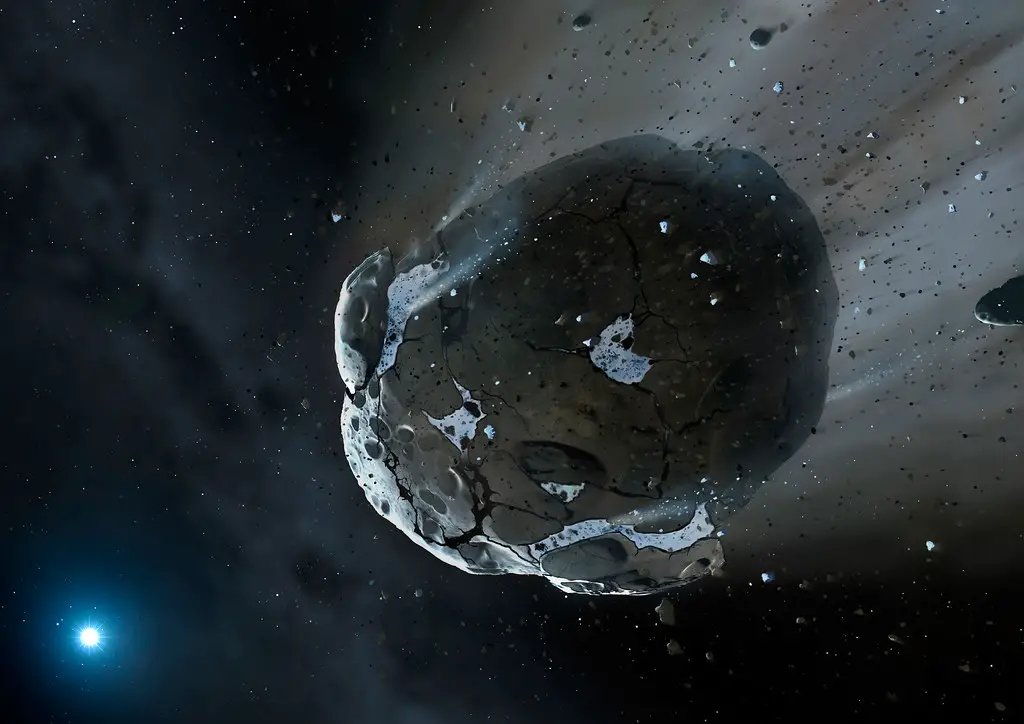A group of international scientists, led by renowned astrophysicist Dr. Emily Chen, have made a ground-breaking discovery that could fundamentally alter our understanding of the universe and the trajectory of the search for extraterrestrial life: they have discovered water molecules, an essential component of life, on the surface of a far-off asteroid known as Epsilon-12. This remarkable discovery, made possible by cutting-edge spectroscopic research methods, not only solves the mystery surrounding this celestial entity but also creates new avenues for investigating the origins of water in our solar system. The team’s research, which included a thorough analysis of data gathered during the historic NASA mission known as the Asteroid Insight Initiative, which came to an end in 2022, confirms the importance of space exploration in revealing the mysteries of the universe.
Unveiling A New Frontier
The scientific community is particularly interested in the asteroids Iris and Massalia because of the recent and significant finding that they have water on their surfaces. As scientists learn more about the consequences of this discovery, a rush of excitement and curiosity has been generated. The discovery of water on these asteroids not only illuminates the distribution of water in our solar system but also sparks speculation about the possibility of life beyond Earth. This discovery has opened up conversations about the enormous opportunities that astronomy and astrobiology have, opening the door to more investigation and scientific findings that have the potential to fundamentally alter our view of the cosmos. These discoveries have a significant effect that extends beyond the confines of our solar system and provides access to a cosmos rife with mysteries that remain to be solved via continued investigation and study.
In the past, researchers used historical NASA SOFIA (Stratospheric Observatory for Infrared Astronomy) data to identify whether or not these asteroids contained water molecules. The incredible SOFIA is a key component in deepening our understanding of the vast universe. It was honored for its significant contributions to space research programs prior to its retirement. Its priceless contributions continue to influence our understanding and pique our interest in the mysteries of the cosmos. Our understanding of the challenges of space exploration has grown as a result of the data acquired from SOFIA’s missions, which have also opened up new study directions.
The Implications
The scientific community has been rocked by the recent revolutionary discovery of water on the surface of an asteroid, a celestial entity that was previously believed to be barren. This discovery not only disproves conventional wisdom but also provides a fascinating window into the complex network of cosmic components that make up our solar system. This discovery broadens our search for the answers to the cosmos by illuminating the existence of water in previously undiscovered regions and creates a world of opportunities for future research. It is a symbol of the unwavering quest for knowledge and gives us hope as we continue to look for evidence of extraterrestrial life.
Often thought of as relics from the early stages of our solar system, asteroids are interesting celestial objects that provide an enthralling glimpse into the conditions that prevailed during the planetary formation phase. Not only does the concept of water existing on these asteroids excite the imagination, but it also raises the astounding potential of a substantial amount of water. This in turn presents an exciting possibility: life may exist far beyond the limits of what we currently understand about the universe. The deep ramifications of this finding not only underscore the enormous potential for deciphering the mysteries of our cosmic surroundings but also kindle a deep curiosity about the interdependence of life across the wide cosmos.
What’s Next?
Even though this revolutionary finding represents a critical turning point in our knowledge, much more needs to be done. Understanding more about the type of water that has been found—whether it is liquid, frozen, or occurs in minerals—will be essential to expanding our understanding and solving the puzzles surrounding these asteroids. This thorough examination may give scientists important new information about the current environmental circumstances and maybe shed light on the possibility that life exists in these celestial planets. Subsequent investigation could uncover complex connections between the compositions of the asteroids and their water sources, providing insight into the origins and development of these intriguing solar system objects. The quest for this knowledge offers a window into the intricacies of the cosmos and possible ramifications for our comprehension of the universe, as well as opening doors to new areas of scientific investigation.
Furthermore, this ground-breaking finding inspires amazement and awe at the limitless possibilities that await us on our cosmic adventure in addition to highlighting the importance of continued space exploration and pushing the boundaries of human understanding. Every new discovery we make as we bravely venture farther into the vastness of the cosmos holds the potential of solving mysterious riddles and deepening our understanding of the limitless unknown that envelops us.
In summary, the discovery of water on the surfaces of the asteroids Massalia and Iris represents a major advancement in our knowledge of the cosmos. It changes our understanding of asteroids and creates new and exciting avenues for the hunt for extraterrestrial life. With each such finding, we get a little bit closer to providing answers to some of the most important concerns concerning our existence.
Sources
- NASA mission helps detect water on asteroids surface
- Water on two asteroids surface discovered
- Water directly detected on asteroid surface
- Water found on asteroid surface
- Bennu Asteroid Sample Contains Carbon, Water
![]()
